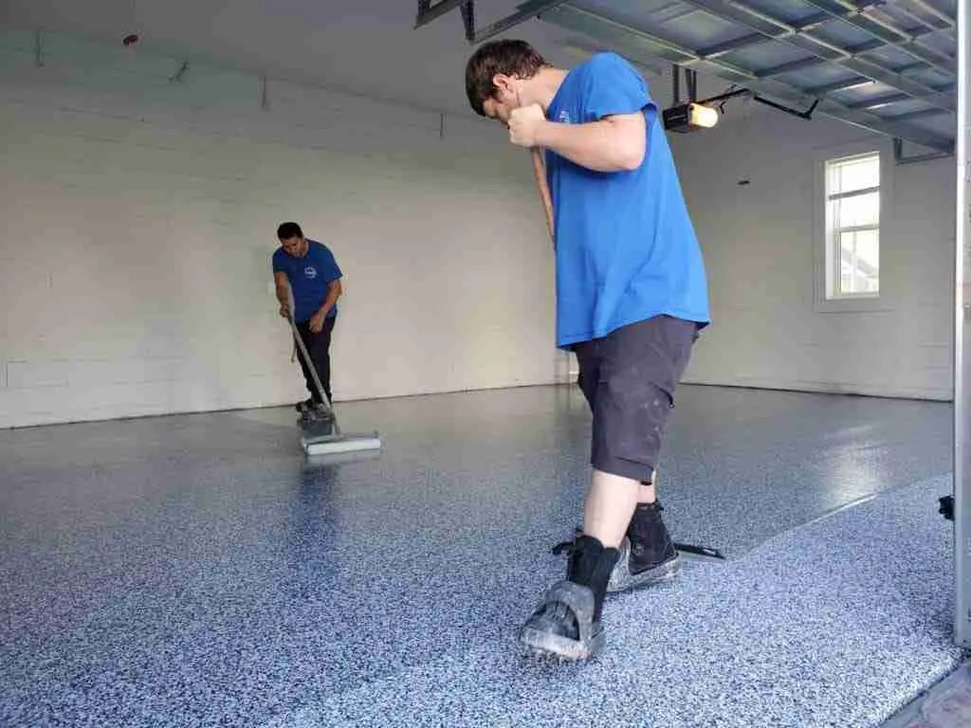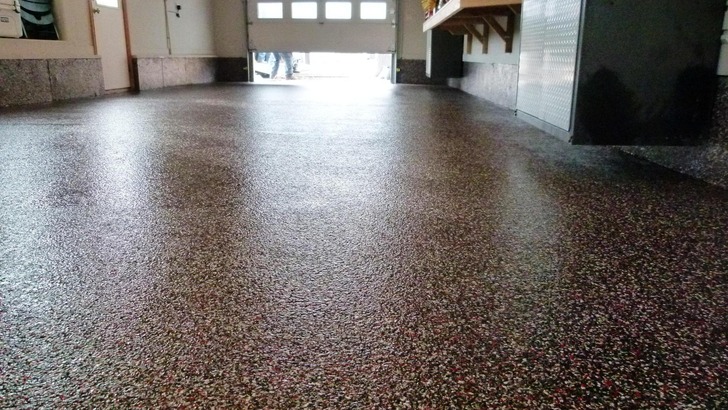Many people appreciate the unique, customizable options and the shimmering look that flake floors offer. The variety of design options available and the ease of caring for flake floors, coupled with their durability, has made them a flooring choice for many people, even in the interior of homes. But just like any other flooring investment, flake floors require maintenance so that they stay in good condition. This article is intended to help you maintain the appearance and the longevity along with the functional features of the flake floor, whether your flake floor is a new epoxy installation or an older one that needs refreshing.
What Are Flake Floors?
Flake floors are simply floors that are coated in a textured paint that has a resin bound finish. The flake flooring finish is slip resistant and very strong so many people use it for protective purposes in garages, showrooms, commercial kitchens, and other commercial spaces like retail shops. For added visual appeal, the finish is made using colored vinyl chips and flakes that are cemented into the resin. The flakes are also strong and help in protecting the flooring system from moisture, UV rays, and chemicals.
Flake floors are used in:
- Garages
- Workshops
- Basements
- Retail Stores
- Commercial Kitchens
- Showrooms
Proper maintenance will keep your flake floors glossy, vibrant, and damage free for years to come.
Why Maintenance Matters
Although flake floors are sturdy, they are not completely maintenance free. Regular cleaning and preventative care help avoid:
- Scratches and scuffs
- Dirt and grime buildup
- Dullness or loss of shine
- Chemical staining
- Wear from heavy traffic
Consistent maintenance will extend the longevity of your floor and help you avoid costly repairs or re-coating.
Daily & Weekly Cleaning Tips
Dry Sweep or Dust Mop Regularly
Dust, dirt, and grime can act like sandpaper on the floor’s surface over time. Use a microfiber dust mop/soft broom and dry vacuum. For high-traffic areas, daily sweeping is ideal.
Damp Mop as Needed
When your floor starts looking dirty, mop it with warm water and a mild, pH neutral cleaner. Avoid vinegar, bleach, and harsh chemicals that will dull or damage the topcoat.
- Mix your cleaner with warm water in a bucket.
- Use a damp (not soaking wet) microfiber mop.
- Mop in sections and allow the floor to air dry.
- Avoid overly wet mops, especially in garage floors, to prevent puddles from pooling in low spots.
- Recurring & Deep Cleaning
Scrubbing with a Soft Bristle Brush
For tough stains, tire tracks, or greasy residues, take a soft bristle brush along with a gentle degreaser formulated for epoxy or resin floors. Apply, allow it to sit for a few minutes, scrub gently, and rinse.
Preventing Scrapes
Place rubber mats or felt pads under heavy furniture, tool boxes, and machines. Garages should have mats under cars to minimize hot tire pickups.
Removing Winter Salt & Gravel
Places like Calgary, or any area with harsh winters, have salt and gravel that eats away at your topcoat. During the winter, you should be sweeping regularly and rinsing the floor to eliminate salt residue.
Cleaning Spills Promptly
Decorative flake floors may be resistant to several chemicals. However, your floors can be damaged or stained with prolonged exposure. For floors, oil, gasoline, and battery acid stains should be wiped immediately.
Regularly Check the Floor for Potential Problems
Monitor the floor for:
- Inequality in the surface (chips, gouges, dull areas, discoloration)
- Surface deterioration (peeling, bubbling, blistering)
- Water intrusion
The sooner potential problems are identified, the sooner minor issues can be addressed before costly repairs are needed.
Schedule Topcoat Application for Every Few Years
The topcoat wears down with time, particularly in areas with heavy traffic. Reapplying a clear topcoat every 3-5 years restores the surface shine and protects the underlying flakes and resin. For recoating services, refer back to your original installer or contact a reputable search flooring company.
Common Sense Measures
- Disallowed are harsh cleaners (ammonia, bleach, and citrus)
- Abrasive tools (e.g. steel wool, stiff-bristle brushes)
- Dragging (rather than lifting) heavy items or furniture
- Pressure washing inside
- Too high a water pressure (damaged seams and edges)

Garage Flake Floors Bonus Tips
- Place a drip tray under your car
- Use snowmelt mats to absorb winter salt
- Inflated tires make for hot tire pickup as well.
FAQs
Q. Decorative flake floors and their lifespan?
Care and maintenance improve the 10-20 years lifespan, depending on exposure and use.
Q: Can I use a steam mop on flake floors?
It’s best not to use a steam mop. The heat and moisture will eventually weaken the resin.
Q: What happens if the floor loses its shine?
The floor will regain its shine with a new topcoat and professional polishing.
Final Thoughts
Decorative flake floors will last a long time, but maintenance is helpful. Routine cleaning, protective measures against excess damage, and monitoring surface wear will help keep the floors in pristine condition. A clean and well-kept flake floor, whether in a garage, basement, or commercial space, enhances the area’s functionality and attractiveness. If the floors are in need of a refresh, flooring specialists are recommended for more affordable and faster recoating and repairs compared to full replacements. A well-maintained decorative flake floor will continue to shine and offer optimal performance.

